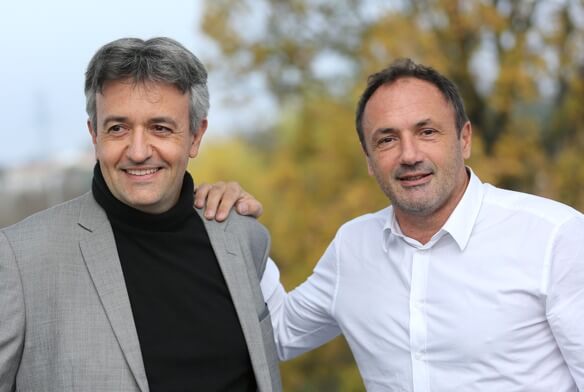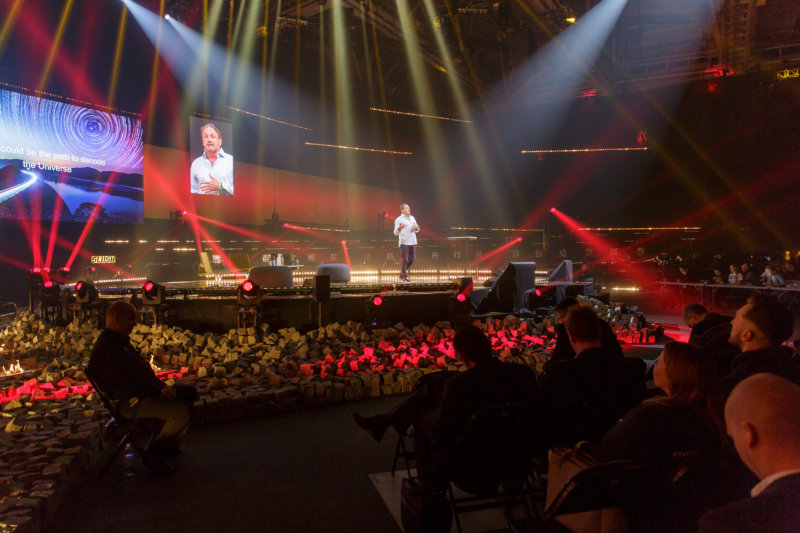French IoT unicorn Sigfox carries hopes of a nation hungry for a global startup hero
Xavier Torres-Tuset saw his future the first time he heard of Sigfox. The French engineer had been interested in building a new type of tracking device for remote objects, one that was unlimited by range. But the combination of cost, battery life, and connectivity created what seemed like an unsolvable puzzle.
Then he discovered Sigfox, a French startup that is building a global communications network dedicated to Internet of Things devices. The company had developed technology that allows inexpensive devices to send tiny packets of information over long distances while using little power. It had solved his unsolvable puzzle.
Using Sigfox technology, Torres-Tuset launched a Kickstarter campaign to develop his first product: the HidnSeek smart global positioning tracking device. From there, he’s turned HidnSeek into a company with a suite of trackers, including a new one for boats called Swail (coming soon).
“It was Sigfox that inspired us to develop these products that were not in the market,” Torres-Tuset said. “Because Sigfox was there, and they were offering these attributes, it seemed obvious to us how to hop on their network and develop these products and make a business out of them.”
Those HidnSeek gadgets are now among the 10 million devices connected to the Sigfox network. Riding a wave of excitement, Sigfox has now raised over $400 million in venture capital, including $160 million in November, to fuel its expansion into 60 countries. As one of the most well-funded startups in French history, Sigfox is regularly singled out for praise by local government officials as an example of the entrepreneurial spirit they hope will transform the nation’s sluggish economy.
Now, Sigfox faces the challenge of delivering on the hype and hope. Despite pioneering this market, Sigfox faces growing competition from alternative IoT networks backed by other startups and telecom providers. Analysts note that having built the world’s largest IoT network, Sigfox and its partners must now convince developers to use the capacity they’ve put in place. And even cofounder and CEO Ludovic Le Moan is quite blunt about the sales and technical challenges the company must overcome.
Still, he remains convinced Sigfox has the potential to become a disruptive force that helps realize the potential of an IoT revolution that’s always been just over the horizon.
“The Sigfox business model and vision is to provide a worldwide network for IoT,” Le Moan said. “We want to be like a giant radio telescope that can listen to messages from the objects all around us. It will be tough to achieve. But we have the right partners and strategy to make this a reality.”
A Silicon Valley story…in France
In a country where politics and economics remain heavily centralized in the nation’s capital of Paris, Sigfox stands out for being located several hours to the south, near Toulouse, France’s fourth-largest city. Sigfox’s headquarters can be found just outside Toulouse in Labège, a town of commuters, low-slung office buildings, and strip malls that resemble the look and feel of Silicon Valley’s suburban aesthetic.
That’s fitting, because the arc of the company’s founding is not unlike the classic Silicon Valley startup tale. It begins with Christophe Fourtet, who worked in the Toulouse region for many years with Motorola’s semiconductor division, which was spun off into a separate company called Freescale in 2003.
Fourtet’s specialty was radio communications and cellular technologies, and by 2008 he was thinking a lot about the surging interest in IoT. For all the hype, IoT’s impact was being limited by the technical challenges and costs of keeping the gadgets constantly connected to mobile networks. It’s one thing to connect a baby monitor over your home Wi-Fi. It’s another thing if you want to install 1 million sensors across a city. That scale was hard to achieve, given that the wireless connectivity drained batteries and was expensive.
Numerous companies were trying to tackle this problem by pushing the boundaries of technology. Fourtet had a counterintuitive idea: The solution might be to go backwards and used the type of radio signals that had been around for decades.
“I came back to some very frugal technologies,” he said. “There is obviously some need for low-energy, small data transfers, with minimal infrastructure.”
As Fourtet spoke, he was seated in his Sigfox office, surrounded by vintage radio gear. Years before cellular networks, such gadgets were capable of transmitting communication over long ranges while being economic with power usage. Fourtet began building a more compact modern version to refine these ideas.
Itching to do his own thing, he left the comfort of Freescale to pursue the risky entrepreneurial path. But as he did so, he quickly realized he needed a cofounder who could shoulder the business end of a startup.
That’s when he met Le Moan, a serial entrepreneur who had founded Anyware Technologies, a company that was tackling similar issues back when the industry jargon was “machine-to-machine” or M2M communications. Le Moan saw what Fourtet was doing and was immediately convinced he was on the road to cracking the code for IoT communications.
In addition to being cofounders, the two men have formed a rather public mutual admiration society. Le Moan often refers to Fourtet as the “Mozart of the radio.” Fourtet is equally effusive.
“It was an incredible meeting that first time with Ludovic,” Fourtet said. “He realized how we could connect really simple things. And he was quite fast in transforming that into a business idea. I knew nothing of the world of venture capital. I couldn’t have raised money without him.”

Above: Sigfox cofounders Christophe Fourtet (left) and Ludovic Le Moan
This was the idea: Build a global communication network for IoT. Partner with incumbent telecom providers who had the capacity to help install things like communications antennas across countries. Charge a basic subscription for gadgets that want to connect.
Those gadgets would use a small Sigfox module that allows them to connect to the network. The devices only turn on and connect when they need to send small bits of data, typically about 12kb, over unlicensed spectrum. That’s the key to allowing long battery life, which in turns means someone can install them on a large scale without having to run extensive electrical wires or constantly change batteries.
While the vision came into focus quickly, convincing the rest of world took a bit longer.
“In the beginning, we spent a lot of time justifying the need for a low-power solution,” Le Moan said. “People thought we were crazy. Everyone else was trying to increase bandwidth.”
Eventually, however, a network was built across France, and, as it came online, it started attracting attention and customers. Today, one of its biggest customers is Verisure Securitas Direct, which has connected about 1.2 million of its alarms to the Sigfox network.
Still, for many people in France, the first time they heard of Sigfox was in February 2015 when the company announced it had raised $115 million in venture capital. At the time, that was the largest round ever in French history.
The eye-catching fundraising came in the midst of a national push by the French government to encourage and support entrepreneurs through a program called “La French Tech.” Suddenly, France had a new startup poster child it could brag to the world about.
“This funding will demonstrate that we can work with other partners to provide a network that will help us achieve our vision of a world with more connected devices,” Le Moan said in an interview at the time. “It was not easy when we started to raise this round because we didn’t know what the market would be like.”
Not alone
Of course, with success comes competition.
While Sigfox defined a market and raced ahead, plenty of others are trying to solve the same riddle and seize the same opportunity.
Most notable among these is the LoRa Alliance, a constellation of companies developing an IoT communication platform with a different protocol and philosophy. In recent years, there have been sometimes heated disagreements between the two camps over their relative technical merits, their respective business models, and which of the two is really embracing an “open” versus “proprietary” technology.
LoRa supporters like to say it’s open-sourced, but the underlying intellectual property and the radios needed for the network are controlled by SemTech, a California semiconductor company (which now licenses the radio technology). Critics have slammed Sigfox for being a risky bet because its technology is proprietary, but the company points out that it gives the underlying protocol away free to anyone who wants to build devices for its network.
In any case, LoRa has also continued to make progress. In France, IoT startup Actility raised $25 million in 2015 to develop its equipment and software platform that supports the LoRa protocol. The investors included Foxconn and Orange, France’s larger telecom carrier. The company, which focuses on selling devices and software, rather than operating the network, also announced a partnership with Cisco last year to develop LoRa-related solutions.
“We think this is going to be about billions and billions of interactions,” said Mike Mulica, who was hired as Actility CEO last summer. “LoRa offers a scalable solution, and we have a lot members of the alliance who are all pulling in the same direction.”
Meanwhile, telecom operators are jumping in. Vodafone, for instance, announced in October that it would begin rolling out a NarrowBand Internet of Things network in four European countries, starting in early 2017. This system uses licensed wireless spectrum to carry the data. In the U.S., Sigfox launched its network a year ago on its way to expanding to 100 cities. But in the coming year, it may face competition from Verizon, which recently began trials of its own IoT network.
“All these guys are trying to get scale, or at least trying to give the impression of scale,” said Gartner analyst Sylvain Fabre. “It’s truly a race, and not everyone is going to make it.”
The road ahead
On a late November day, the Sigfox campus in Labège welcomed a high-profile visitor: President François Hollande. Though Hollande’s popularity has dipped as low as the single digits at times last year, it was under his watch that the government launched the French Tech program.
While Sigfox’s story began well before the French Tech program, Hollande clearly felt a sense of pride as he toured the headquarters, where the company has announced it is expanding into several nearby buildings to accommodate its global workforce, which has grown to 310. The campus also hosts IoT Valley, a startup accelerator that concentrates on new companies making connected products. And the two cofounders have created the Sigfox Foundation, a nonprofit that helps develop IoT projects for groups focused on the environment, the arts, and social issues.
“In recent months, I have wanted to push innovation,” Hollande said. “We see here that there is a whole environment that can be favorable to the future of the French economy.”
Hollande’s visit came on the heels of some more big news for Sigfox: In early November, the company raised $160 million in venture capital. And Sigfox made it clear that it could have raised more, and still might as part of that round. But what seemed to be just as important as the money was the long list of investors: Salesforce, Total, Parrot cofounder Henri Seydoux, Alto Invest, Swen CP, and Tamer Group. Previous investors also participated in the round, including Bpifrance, Intel Capital, Air Liquide, Idinvest Partners, and IXO.
That round of funding let Sigfox send a statement to developers that the company has scale and momentum on its side. Le Moan knows the company is going to be facing growing competition. But Sigfox says the latest round of funding will help it expand from 26 countries to 60 by 2018, and to reach profitability, as well.
Partnering with Salesforce will allow companies on Sigfox to gain more intelligence and insight from data they are sending to the cloud. That Sigfox cloud is part of another partnership with Microsoft’s Azure cloud. And the company has a major partnership with Samsung, which is building its technology into its own IoT services and products.
But the investment from France’s Total, the world’s fourth-largest oil and gas company, is equally interesting. While Sigfox may have the biggest IoT network, it still needs to attract users for all that capacity. It’s one thing to get an entrepreneur to use Sigfox technology for their Kickstarter-funded gadget that they might sell a handful of. What Sigfox would really like, however, is for a company like Total to place a massive bet on Sigfox and use it to transform their business.
“The scope of possibilities is enormous!” Le Moan said in an interview on a Total blog. “Sigfox could, for example, help you completely re-invent your customer relationships by installing sensors that would allow you to offer new high-value-added services. Sigfox could also give you ways to improve predictive maintenance at your industrial sites. Today, you’ve got sensors on some of your key equipment, but they are costly and their batteries need to be changed on a regular basis. With Sigfox, you could put sensors on all your devices for less, and with very little maintenance.”
At the same time, Sigfox has been trying to address another challenge: The cost of its modules. The company recently introduced a significantly cheaper version that costs $2 per unit.
“We need to drive the evolution of the technology so we can drive the price down,” Le Moan said. “That is a big challenge we have.”
Sigfox has grown to 10 million devices on its network as it continues to build out infrastructure around the world, and analysts are now watching to see if the company can accelerate that adoption. This coming year may demonstrate whether Sigfox can continue to ride the wave of IoT innovation and realize its global ambitions.
“They’re doing a very good job at shaking up the cellular industry,” said Jamie Moss, an IoT analyst at Ovum Research. “They’ve done a great job of showing how a small technology company can shake a large, established industry into action. 2017 is going to be a very telling year. We’ll have a much better idea which of these IoT technologies is going to survive.”

Above: Le Moan at Slush.
